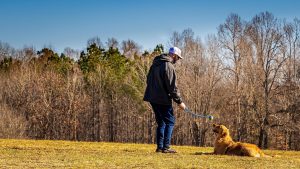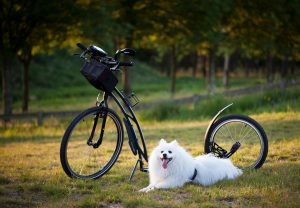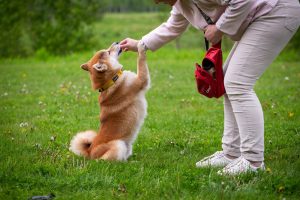These are two very useful commands you need to teach your puppy. Think of it this way, if your puppy pulls on a leash, you only need to tell it to slow down. And if you teach that command to your puppy, it will slow down and reduce leash pulling.
Here is a fun fact for you: Almost half of the leash jerks happen when the dog is too far ahead forging. And one-third of leash jerks happen when the dog is too far behind lagging.
So, with just two simple commands, you can reduce the amount of leash jerks and give your puppy a much higher quality of life.
Why should you punish your puppy with leash jerks? Absolutely inhumane. Instead, you can make walking fun and enjoyable for both of you.
What is the solution for a lagging dog? You ask him to speed up. And what is the solution for forging dog? Well, ask him to slow down.
How to teach a dog to speed up?
Here is a fun fact: these two commands are basically a solution for the problem. When your dog is slow, you ask him to speed up and vice versa. Instead of jerking a dog because he is slow, we are telling him he is doing something wrong and we need him to speed up.
As we have talked about previously, the best way to teach a dog to do something is the basic learning sequence command – lure – response – reward. Or in other words, putting a behavior on cue. It is the art of dog training.
Here is how the basic learning sequence looks in this case. You start by walking with your dog and then:
1 – You say speed up
2 – You keep your walk faster, or increase your speed
3 – Your dog responds to your faster walking
4 – Praise the dog, good boy, and give him a treat
Of course, you might leash jerk your dog initially when you speed up. But most dog owners are already jerking their dogs without giving the command speed up. This way, at least you’re teaching your dog to do something you want. Fun fact: if you do not want to jerk your dog, you can just ignore him. This is the best cue for speeding up. If you have the level of dog follower state of mind, your puppy will follow.
How to teach a dog to slow down?
We said before that slow down and speed up solve the problem of the other. When we try to teach a dog to slow down, we do it systematically.
1 – Say steady
2 – Walk slowly
3 – The dog slows down
4 – Praise the dog
When you give the command steady, half a second later slow down your pace.
When and where to practice slow down and speed up?
Well, isn’t it obvious? These two commands work when you walk with your dog. But before you have a reliable dog, you can practice along the sidewalk. What is the benefit of training along the sidewalk? Well, it reduces your dog’s reactivity toward other dogs.
You walk in a straight line, you see a dog approaching, and you just practice slow down. As your dog is slowing down, you can get him in sit, and wait for the other dog to pass by you.
To get a reliable slow down and speed up, you have to expose your dog to different environments. This will teach your puppy that the commands are the same in every environment. So, go to a different environment, and after say, 25 to 30 yards, stop. Do not move until the dog looks back at you. It is your pup’s sign that he is OK with the environment.
At this point, you can walk and train your dog. If your puppy is not OK with the environment, your training will be a failure.
You definitely want to get a reliable slow down command. It prevents so many things. For example, your dog moving out in front of you. If your dog is so far ahead of you, he will react to other dogs. You are basically now training a protection dog because of the tension in the leash. It tells your dog he has to protect you.







